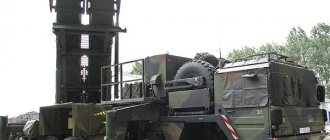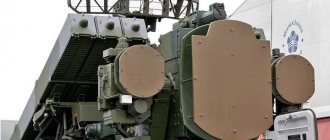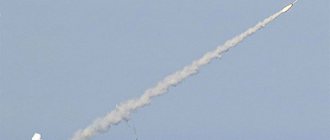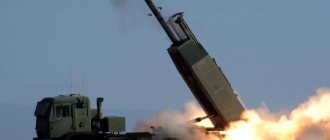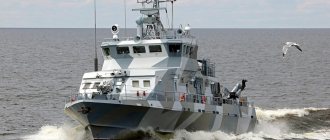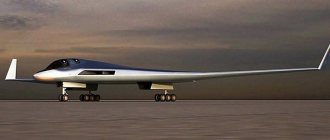TASS DOSSIER. On November 30, 2022, a source in the military-industrial complex reported to TASS that in mid-November in the Russian Arctic, a MiG-31K fighter that took off from the Olenegorsk airfield (Murmansk region) for the first time carried out a test launch of the Kinzhal hypersonic missile at the Pemboy test site (located to the north). east of Vorkuta). Another source confirmed the fact of the tests, Fr. The Russian Aerospace Forces did not comment on the information provided by the sources.
What is known about the aviation missile system with the combat hypersonic aeroballistic missile "Dagger" - in the TASS material.
Project history
Russian President Vladimir Putin first announced the creation of this weapon when delivering a message to the Federal Assembly on March 1, 2022. Then he announced the existence in Russia of a “high-precision hypersonic aircraft-missile system” that “has no analogues in the world.” According to the head of state, the tests of the complex were successfully completed, and from December 1, 2022, it began to carry out experimental combat duty at the airfields of the Southern Military District.
At the same time, a video was shown showing the takeoff of a MiG-31 aircraft with a Kinzhal missile on the central suspension point, and then computer graphics depicting the destruction of ground and surface targets.
Until this moment, neither official nor unofficial sources had reported the existence of an air-launched hypersonic missile in the Russian Federation. Therefore, the statement of the President of the Russian Federation became a sensation for Russian and foreign military experts.
On March 10, the Russian Ministry of Defense announced a practical combat training launch of a hypersonic missile of the Kinzhal high-precision aircraft missile system “in a given area.”
On May 9, two MiG-31K aircraft (tail numbers “90 red” and “92 red”) with the Kinzhal missile system took part in the aerial part of the Victory Parade in Moscow.
On July 2, TASS, citing a source in the Russian military-industrial complex, reported that the Kinzhal will be tested on the Tu-22M3 long-range bomber, which will be able to carry several such missiles, and the range of hitting targets will increase to 3 thousand km.
On July 19, 2022, the Russian Ministry of Defense reported to journalists details of the trial operation of hypersonic missiles of the Kinzhal complex. According to information from Deputy Commander-in-Chief of the Aerospace Forces of the Russian Federation Sergei Dronov, since taking up experimental combat duty on December 1, 2022, the Kinzhal carriers - MiG31K fighters - have completed more than 350 flights, with 70 of them carried out with the aircraft refueling in air. Since April 2018, the complex, according to the department, has been on scheduled duty over the Caspian Sea.
SAM "Dagger" (3K95, export - Blade) - sea-based anti-aircraft missile system
The Kinzhal air defense system (3K95, export - Klinok) is a multi-channel, all-weather, autonomous complex capable of repelling a massive attack of low-flying anti-ship, anti-radar missiles, guided and unguided bombs, airplanes, and helicopters. In the 80s it was created under the leadership of S.A. Fadeev at NPO Altair.
SAM "Dagger" (3K95, Blade) – video
The complex is equipped with its own radar detection equipment (module K-12-1), providing the complex with complete independence and operational actions in the most difficult situations. The multichannel complex is based on phased array antennas with electronic beam control and a booster computing complex. The main operating mode of the complex is automatic (without the participation of personnel), based on the principles of “artificial intelligence”.
The television-optical target detection devices built into the antenna post not only increase its immunity to interference in conditions of intense radio countermeasures, but also allow personnel to visually assess the nature of tracking and hitting targets. The radar equipment of the complex was developed at the Kvant Research Institute under the leadership of V.I. Guz and provide a detection range of air targets of 45 km at an altitude of 3.5 km.
UVP air defense missile system "Dagger" on the patrol ship "Yaroslav the Mudry"
The Kinzhal air defense system can simultaneously fire at up to four targets in a spatial sector of 60 degrees. at 60 degrees, while aiming up to 8 missiles in parallel. The reaction time of the complex ranges from 8 to 24 seconds depending on the radar mode. The combat capabilities of the Kinzhal compared to the Osa-M air defense system have been increased by 5-6 times. In addition to the missile defense system, the Kinzhal air defense system can control the fire of 30-mm AK-360M assault rifles, finishing off surviving targets at a distance of up to 200 meters.
The complex uses a remote-controlled anti-aircraft missile 9M330-2, unified with the missile of the Tor land complex. The missile launch is vertical under the action of a catapult with further deflection of the missile by the gas-dynamic system towards the target. The engine is started at a safe altitude for the ship after the rocket has descended.
The warhead is detonated directly at the command of a pulse radio fuse in close proximity to the target. The radio fuse is noise-resistant and adapts when approaching the water surface. Warhead - high-explosive fragmentation type. The missiles are placed in transport and launch containers (TPC). The missiles do not need to be tested for 10 years.
SAM “Dagger” on the BOD “Admiral Vinogradov”
The launchers of the Kinzhal air defense system were developed by the Start design bureau under the leadership of chief designer A.I. Yaskina. The launcher is below deck and consists of 3-4 drum-type launch modules, each containing 8 TPKs with missiles. The weight of the module without missiles is 41.5 tons, the occupied area is 113 square meters. m. Calculation of the complex is 8 people.
Ship tests of the complex began in 1982 on the Black Sea on a small anti-submarine ship, Project 1124. During demonstration firing in the spring of 1986, 4 P-35 cruise missiles were launched from coastal installations at the MPK. All P-35s were shot down by 4 Kinzhal air defense missiles.
Antenna post 3Р95 of the Kinzhal air defense system on the Project 1155 BOD
The tests were difficult and missed all deadlines. So, for example, the “Kinzhal” air defense system was supposed to equip the “Novosrossiysk” aircraft carrier, but it was put into service with “holes” for the “Dagger”. On the first ships of Project 1155, one complex was installed instead of the required two. And finally, in 1989, the Kinzhal air defense system was officially adopted by large anti-submarine ships of Project 1155, on which 8 modules of 8 missiles were installed.
Currently, the Kinzhal air defense system is in service with the heavy aircraft-carrying cruiser Admiral Kuznetsov, the nuclear-powered missile cruiser Pyotr Velikiy (Project 1144.4), large anti-submarine ships Project 1155, 11551 and the newest patrol ships of the Neustrashimy type. The Kinzhal air defense system is offered to foreign buyers under the name Klinok air defense system.
Anti-aircraft guided missile 9M330-2 SAM "Dagger"
Tactical and technical characteristics of the Kinzhal air defense system (3K95, export – Blade)
| Target range | 1.5 – 12 km |
| Target engagement height | 10 – 6000 m |
| Target speed | up to 700 m/s |
| Number of simultaneously fired targets in the 60×60° sector | up to 4 |
| Number of simultaneously aimed missiles | up to 8 |
| SAM guidance method | telecontrol |
| Target detection range at an altitude of 3.5 km from own detection means | 45 km |
| Reaction time to a low-flying target | 8 s |
| Ammunition | 24-64 missiles |
| Weight | SAM weight: 165 kg Warhead weight: 15 kg Complex weight: 41 tons |
| Personnel | 13 people |
Photo of the Kinzhal air defense system on the Severomorsk BOD
Model of a shipborne launcher 3S95E of the export Klinok air defense system with means of loading missiles
Control panels for the Kinzhal air defense system
UVP air defense missile system "Dagger" on the nose of the SKR "Neustrashimiy"
Source
Performance characteristics
Brief characteristics of the “Dagger” were named by the President of the Russian Federation in his speech to the Federal Assembly on March 1, 2022: the speed is ten times the speed of sound; range - more than 2 thousand km; the missile maneuvers in all parts of its trajectory, which allows it to overcome all air and missile defense systems; equipped with conventional and nuclear warheads.
Additional details about the new missile were announced by Deputy Minister of Defense of the Russian Federation Yuri Borisov in several conversations with journalists in the spring of 2022. According to him, the MiG-31 fighter was chosen as the carrier because “it is best suited to accelerate this missile to the required speeds at the required altitudes.” The complex's multifunctional warhead allows it to hit both stationary and moving targets, including enemy ships.
According to Borisov, ten Kinzhal carriers are on experimental combat duty.
"Dagger" to the envy of enemies
The appearance of the Kinzhal hypersonic weapon in service with the Russian army caused a lot of bewilderment among various military blocs, in particular, we are talking about NATO, since the first American prototype of a hypersonic missile is expected to be tested only in 2019, while the weapon itself will enter service with the United States no earlier than 2022, indicating the fact that Russia seized the military advantage within a few years of each other.
The key feature of the Kinzhal ARK is the fact that it is impossible to detect the movement of the aircraft-missile system, that is, the hypersonic missile itself can be installed on any carrier aircraft. Moreover, taking into account the officially presented data that the missiles can carry both a conventional and a nuclear charge, the destruction caused by the Russian “Dagger” may turn out to be colossal and even advanced protection will not allow saving the object scheduled for destruction.
Experts believe that modernized versions based on the hypersonic missile will appear in the near future. Capable of flying over much longer distances, say, up to 3-4 thousand kilometers.
Despite the fact that the Ministry of Defense has officially stated that the Russian hypersonic aircraft-missile system “Dagger” is not so promising and innovative, and certainly does not pose any threat to “... the most powerful army in the world...”, independent experts call the ARK "Dagger" the most powerful weapon in the world, capable of destroying almost any object, regardless of whether we are talking about ground targets, sea or space objects.
Kostyuchenko Yuri specially for Avia.pro
Expert assessments
According to experts, the Kinzhal is a single-stage guided solid-propellant missile 9M723 of the Iskander-M ground-based operational-tactical complex, upgraded for air launch. At the same time, experts point to the external similarity of the “Dagger” demonstrated in the videos with the combat equipment of the “Iskander”. In their opinion, the use of an existing “ground-based” missile made it possible to reduce the time required to design new weapons.
As experts suggest, hitting targets at a distance of 2 thousand km is ensured by both the combat radius of the MiG-31 and the flight range of the missile itself. Hypersonic speed at the final stage is achieved both by accelerating the carrier aircraft to supersonic (that is, the MiG-31 acts as the “first stage”), and thanks to its own engines and the trajectory of the rocket.
The aircraft-missile system can be used to destroy important infrastructure facilities - command centers, air and missile defense systems, air bases, aircraft carriers, etc.
According to experts, the Kinzhal missile differs from the “land” version in its redesigned tail section and smaller rudders.
Carrier aircraft for "Dagger"
Considering the fact that the Kinzhal aircraft-missile system is a modern development, the Russian Su-57 fighter-bomber will most likely be used as a carrier aircraft. There is no official confirmation of this yet, however, given the fact that the aircraft has not yet begun to enter service with the Russian army, it is likely that this model is perfectly suited for its purposes.

